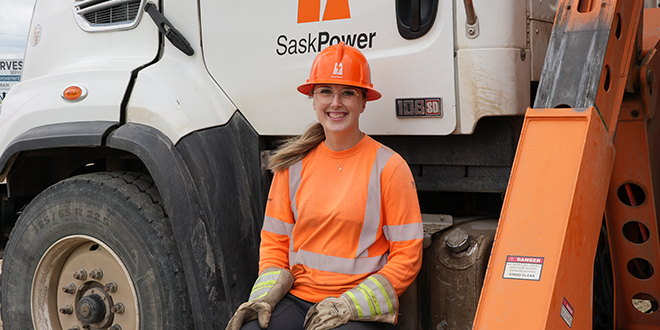Reaching Net Zero in Saskatchewan
August 11, 2023

In 2020, the Federal government set a target of net-zero greenhouse gas (GHG) emissions by 2050. We're committed to reaching that target. The draft Federal Clean Electricity Regulations released on Aug. 10 change that target from 2050 to 2035.
We’re on track to reduce GHGs by 50% below 2005 levels by 2030. But reaching net-zero GHGs by 2035 isn’t feasible. We sat down with SaskPower President and CEO Rupen Pandya to learn why.
1. Why can’t SaskPower reach net-zero GHGs by 2035?
Saskatchewan has relied on fossil fuel to generate power for decades. This means we have one of the longest paths of any Canadian jurisdiction to decarbonize. To reach net-zero we must transform our entire power system - which took almost 95 years to build - in just 12 years. We’ll greatly reduce GHG emissions as we approach 2035, but achieving net zero isn’t feasible because:
- New non-emitting, baseload power generation technologies that could be deployed in Saskatchewan are still developing. (Baseload power is generation that’s always available when needed.) We need more time for those technologies to become commercially available.
- Building even a single generation facility takes years and significant resources.
- It’s extremely costly to replace GHG-emitting power facilities. This is especially true in Saskatchewan, where there’s few customers to pay for a very large power system.
- Much of the world is also decarbonizing their power systems. That means they’re competing for the same resources as we are. Suppliers may be challenged to deliver labour and materials to all jurisdictions in time for 2035.
- The demand for power is increasing. We must replace existing generation, while also increasing generation, transmission, and distribution infrastructure.
We’ve met with Federal officials many times to outline the unique circumstances and challenges we face in transitioning our power system. But the draft Clean Electricity Regulations don’t include the flexibility, funding or support we need.
2. What does net-zero GHGs by 2050 mean for coal plants in the province?
Existing Federal regulations still require the retirement of conventional coal generation before 2030. Unless the current Federal regulations change, we must continue to plan for that timeline. The addition of carbon capture and storage on Boundary Dam Unit 3 means it’s not a conventional coal unit. We're also looking at converting one or more conventional coal-fired units to natural gas. This would reduce GHG emissions and extend the life of the units.
3. Why not run entirely on wind and solar?
We’re planning to add up to 3,000 megawatts (MW) of wind and solar generation by 2035. So, renewable power will play an important role in our future supply mix. But wind and solar are intermittent sources. They don’t produce power when the sun doesn’t shine, or the wind doesn’t blow. That’s why it’s important to have a diverse mix of generation options -- intermittent and baseload.
4. Why not build new large-scale hydroelectric facilities for non-emitting, baseload power?
With our flatter terrain, Saskatchewan doesn’t have many potential large-scale hydro resources. We also must consider:
- Location. Beyond our existing hydro facilities, there are few opportunities for new hydro development. The options that are available are mostly in northern Saskatchewan, far from where the power is needed.
- Cost. Hydro has very high capital costs.
- Timeline. The development timeline for hydro is at least 12 years. Which means that a new hydro project wouldn’t be available until after 2035.
- Impacts. Environmental impacts make licensing hydro facilities challenging.
- Consultation. As with all new construction, we must consider Indigenous Rightsholders and stakeholder interests.
5. Can you speed up work on developing nuclear power to reach net zero?
Developing nuclear power in a new jurisdiction like Saskatchewan is complex. There are lengthy Federal Impact Assessment and licensing processes. It also requires extensive public engagement and consultation with Indigenous Rightsholders.
Right now, we’re on track to select the site for our first potential nuclear power plant by the end of 2024. By the end of 2029 we expect to earn an approved Impact Assessment, Licence to Prepare a Site and Licence to Construct.
With these 3 approvals in place, we’ll be able to make a final decision by the end of 2029 whether to build a small modular reactor. If we proceed, construction will begin in 2030 and be complete in 2034.
6. Can we buy more renewable power from Manitoba?
We have import agreements with Manitoba Hydro for 290 MW. Beyond these agreements, Manitoba can’t provide more power because they have limited extra power available to export to Saskatchewan.
7. The Federal budget allocated billions of dollars for clean electricity. Can we take advantage of that funding?
There are 2 main funding options from the Federal government:
- The Investment Tax Credit. Currently, there’s little clarity on the Investment Tax Credit rules. It’s possible the credit could lead to some funding. But with Saskatchewan’s relatively small population and the need to replace so much generation we expect that funding to be small compared to how much we need.
- The Canada Infrastructure Bank (CIB). The interest rates that CIB has offered us are similar to our borrowing costs so it’s not a helpful option. But the CIB may provide financing to developers of renewable energy projects. For example, CIB is now supporting a wind project under construction by an independent power producer in the province.
We’re working as fast as we can to reduce our GHGs while providing reliable, sustainable, and cost-effective power. But the reality is that even with a great deal of financial support from the Federal government, net zero by 2035 isn’t feasible. We also need Federal regulatory flexibility that:
- Recognizes the significant emissions reductions that we'll achieve by 2035.
- Provides more time for Saskatchewan to achieve a net-zero GHG future.
We will continue to engage with the Federal government throughout the comment period on the implications the regulations would have on our power grid, and beyond.
8. Can I add solar panels to my home to help the province reach net zero?
Large, utility-scale projects are the cheapest way to add renewable energy to the grid. But rooftop solar through the net metering program is a tool in our toolbox as we work toward reaching net zero by 2050 or earlier.
Learn more:




